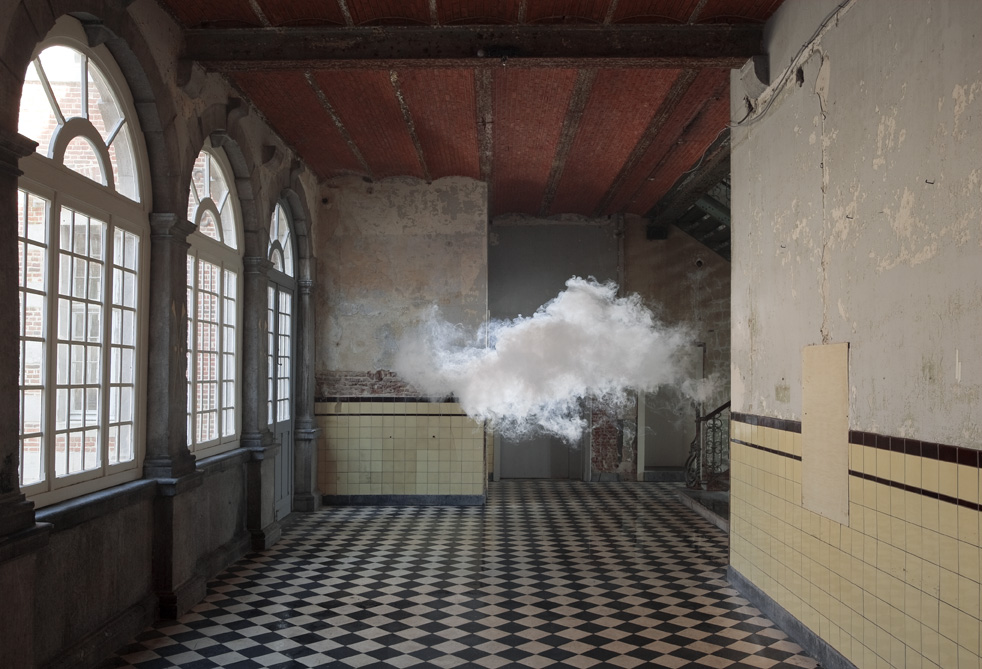On a little street, in between two canals in Amsterdam’s Haarlemmerbuurt neighbourhood, lies the studio of Dutch artist Berndnaut Smilde. It’s a small back room, filled with a coffee machine, packages of mini stroopwafels, large photographs of rain clouds in unconventional places, and a great many prisms. It’s a studio fit for a tinkerer—exactly what Smilde is.
An arts graduate from Hanze University in Groningen, Smilde began his career as a painter. But a lifelong love of building things and working hands-on with materials led him in a different artistic direction. With a portfolio now focused mainly on sculptures and installations, Smilde has graduated from canvas to a more three-dimensional approach. His work is often reacting to spaces and architecture, bringing the natural into unnatural situations and exploring the feelings this displacement inspires.
Some of these works include the Nimbus series, in which Smilde creates a rain cloud inside a space and photographs it before the cloud dissipates. He also collaborated with Steve Tomczyk from America’s National Centre for Atmospheric Research to build a large oil-filled prism; with it, he projected big warped rainbows onto buildings, and even across an entire town by installing it in a lighthouse. And Until Askeaton has streetview explores the relationship between two towns called Askeaton: the first, of the oldest towns in Ireland; the second, created by Irish immigrants who travelled to Wisconsin in America’s early days. If you look up Askaeton, Wisconsin on Google Streetview, the image is of a green pasture with a red-and-white barn. At the point of installation, Ireland’s Askeaton had not yet been captured for Streetview. So Smilde created a facade of the barn and propped it up on one of the town’s main roads, creating an exact replica of its American counterpart. Four years after it was put up, the facade was captured up by the Google photo car, and now on Streetview the two places appear to be identical.
Finding artistic power in illusions, Smilde says the majority of his work is made to seem fleeting. Nimbus, the dramatic rain clouds Smilde creates indoors using smoke and water, are an excellent example of this attachment to the ephemeral. “I did [Nimbus] a few times as a performance, but for me it isn’t as interesting because it will always be a bit about how you make the clouds—and because they’re just there for a few seconds, for me the work is really important as a photograph,” he explains. “It represents more the idea of the cloud.”
Aside from feelings of impermanence sparked by urgency, space plays a huge role in Smilde’s work. “The architecture is really important—it functions as a backdrop for the work, as a plinth, almost,” he says. He prefers for his exhibition spaces to be not directly related to the art world, and to have obvious traces of their previous use to provide textures and imply narratives. “Buildings that are in between construction and deconstruction, you can see those different elements,” Smilde says. “What I also really like is the materiality in a space, like a photograph that you can read.” Some of these spaces include an old Belgian castle which used to function as a mental institution, a room in a San Francisco art gallery made to be a replica of the Versailles Hall of Mirrors, and metal shipping containers.
His work is often reacting to spaces and architecture, bringing the natural into unnatural situations and exploring the feelings this displacement inspires.
Seeing something perfectly ordinary—a house, a cloud—in an abnormal space or form is distinctly disquieting, which is precisely Smilde’s intent. He hopes decontextualizing these commonalities will scramble the feelings we associate with them. “What I do most of the time is change the fuse a bit, put things in a different order,” he says. “Things we take for granted normally, like clouds and rainbows, and the way we look at them from a cultural perspective in daily life.” Smilde has taken rainbows (which generally indicate good luck), turned them upside down, and projected them onto people’s houses. When a rainbow is warped and tied to surface instead of sky, is it still that token of good fortune, or perhaps something darker?
Many of Smilde’s concepts take him on wild rides as he figures out how to materialize them. He patches together his ideas by starting out small and growing them gradually, often seeking out new materials and consulting professionals in other fields. “I think most ideas start that way,” he says. “I had this idea when I was working on rainbows that started from a very small prism, but I thought it would be great to take over a lighthouse by making a very large prism in the top. But how do you go about something like that? How do you break light at a very large scale? You start somewhere and it grows. Eventually we did break the light of a lighthouse. It just sometimes takes a year to get there.”
Flip-flopping between space and non-space, disintegration and formation, Smilde’s art occupies an uneasy netherworld—one seemingly skating the line between omens of good and evil. In an age of information, where negative and positive associations run deep, he removes us from these predisposed opinions and instead places us in the precarious position of not knowing. Whether this world of oddities he creates is a paradise or a nightmare, the answer is in our hands.
The finer things: more from our Arts section.










